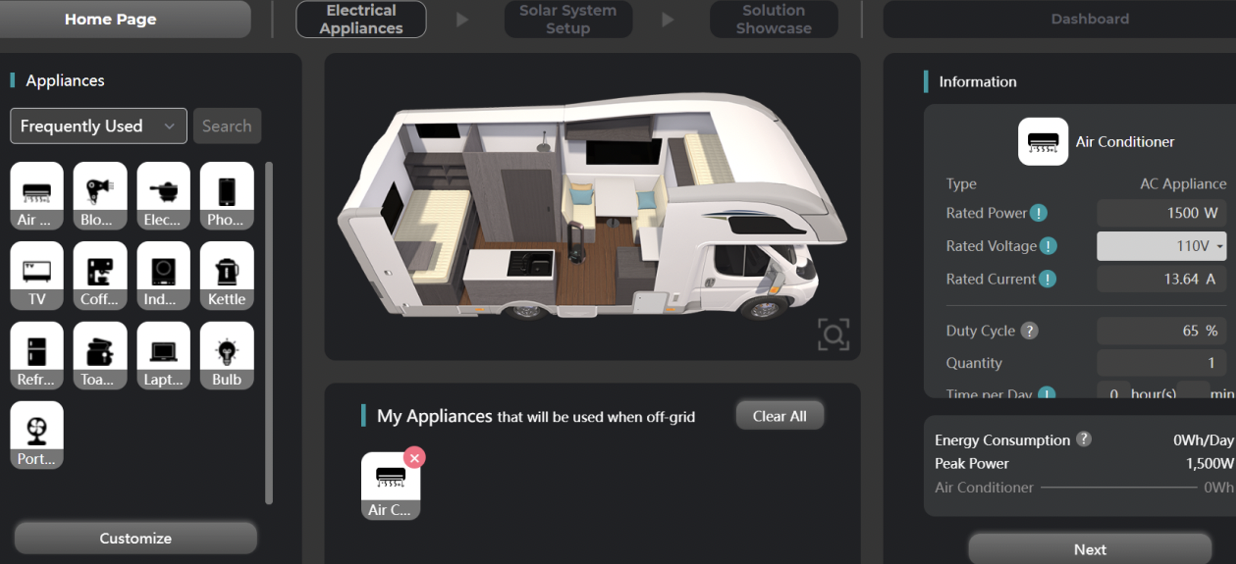Calculate the size of your photovoltaic system and your electricity storage
Photovoltaic Calculator – How big does your photovoltaic system or your electricity storage system have to be so that you can produce your own electricity as much as possible? How much roof space do you need and how much electricity costs do you save?
With the photovoltaic calculator you have the option of calculating your solar system automatically or manually in 7 steps. We will show you which factors the size depends on and what you should pay attention to. The basis for the photovoltaic calculator are the weather data sets of the US Weather Service and the experience from more than 9,500 installed Renogy photovoltaic systems.
Solar Calculator
Would you like to know how much you can reduce your electricity costs with a photovoltaic system and a power storage unit? With the Renogy solar power calculator you can calculate this yourself in just a few steps. With the regional global radiation for your region and with your power consumption, the size of your photovoltaic system of the power storage is calculated.
You can also calculate your system manually in 7 steps
- How much electrical energy do you use per year?
In general, the goal is to produce the required energy yourself with a photovoltaic system, which is why the size of your photovoltaic system primarily depends on your personal electrical energy consumption.
You can find the answer to this question in your most recent electricity bills. In the first step of the photovoltaic calculator, calculate the average power consumption in kilowatt hours (kWh) over the past 5 years (a). How has the quantity developed and what is the price per kilowatt hour?
In the event that you are planning to purchase other large energy consumers, such as a heat pump or an electric car, these consumers must also be taken into account in the total consumption.
Example: The sunshine family has an average energy consumption of 5,000 kWh over the past few years. In the future, a large part of the energy will be produced by a photovoltaic system itself.
- Energy production of your photovoltaic system
Photovoltaic calculator – optimal energy production
In order for you to achieve the highest possible self-consumption with your photovoltaic system, the photovoltaic system should supply at least 25 percent more energy than you consume over the year. Self-consumption is the part of the solar energy that you use directly in the house and that you do not have to buy in the future. 25 percent is an empirical value that we have built into the photovoltaic calculator as a sensible value.
Optimum power production amount of the PV system = 125% x SV
Example: The optimal electricity production for the sunshine is: PV = 125% x 5,000 kWh = 6,250 kWh
- The sun is shining everywhere in US – regional energy yield
Anyone who thinks that photovoltaic systems only pay off in southern countries is badly informed. With an average of 1,100 kilowatt hours per square meter (kWh/a) per year, global radiation in US is almost half that in the Sahara. In addition, the off grid solar system kit in US receive the necessary cooling and self-cleaning.
The regional energy yield [RE] for photovoltaic systems is calculated on the basis of kilowatt hours per kilowatt peak and per year (kWh / (kWp x a) and depends on the region in which you want to set up your photovoltaic system. In step 3 of the photovoltaic calculator, determine the “Regional Energy Yield” from the attached table.
Example: The Sonnenschein family lives in Hesse.
Hesse has a regional energy yield of: RE = 940 kWh/(kWp x a).
- Consider roof alignment, roof pitch and shading
In the past, there was often the opinion that only south-facing modules with an inclination of 30 degrees provided economic returns. The past few years have shown that fortunately this is not the case and that east or west roofs and even flat north roofs provide sensible yields. In the 4th step of the photovoltaic calculator you have to determine your “Personal Deviation Value” from the attached table.
Example: The sunshine family has a roof with a pitch of 30 degrees and a deviation of 40 degrees from the south. This results in a deviation value: AW = 97.5%
Note – Loss of energy due to module shading
When planning your system, you must make sure that the solar modules are installed with as little shade as possible. Adjacent trees, buildings or even antennas, chimneys or dormers on the roof can temporarily shade individual modules and thus impair the performance of all modules that are connected to a cable harness (string).
If you are partially shaded during the day or at certain times of the year, your annual yield will only be reduced minimally. Depending on the size and duration of the shading, you should calculate a discount of between 1 and 5 percent.
If, for example, a shadow only falls on your roof in winter due to the low position of the sun, you can almost completely ignore this shadow in the annual view or in the “photovoltaic calculator”. 80 to 85 percent of the energy is produced in the months of March to October, 15 to 20 percent in the months of November to February.
The power optimizers from Renogy can help here. With this concept, each module has a control device and the system runs almost at 100 percent.
- Your personal regional energy yield
In the event that you do not have a one hundred percent roof, you must take this deviation into account in the solar calculator. This reduces your regional energy yield somewhat.
Example: The sunshine family has a personal energy yield for their roof of 97.5% x 940 kWh/ (kWp x a) = 916.5 kWh/ (kWp x a)
- Size of your photovoltaic system
Now use the photovoltaic calculator to calculate the optimal size of your photovoltaic system [PV]. Divide the optimal energy production [SP] from step 2 by your “Personal Energy Yield” [PE]. If you have more roof area available, you should definitely build your solar system larger. You can certainly use the generated energy.
Example: The sunshine family’s photovoltaic system should be at least 6.82 kWp.
PV = 6,250 (kWh/a) / 916 (kWh/(kWp x a)) = 6.82 kWp
- Calculation of the required roof area
A typical photovoltaic module has the dimensions 1.70m x 1m (= 1.70m²) and an output of 340 Wp. To calculate the required roof area, multiply the system size by a factor of 7 m²/ kWp. Certain open spaces are already taken into account for this factor.
The required roof area [DF] = photovoltaic system [PV] x 7 (m²/ kWp)
Example: In the case of the sunshine family, this results in a roof area of 48 m². 6.82kWp x 7 (m²/kWp).
Did you get along with the photovoltaic calculator and were you able to calculate the size of your photovoltaic system?





